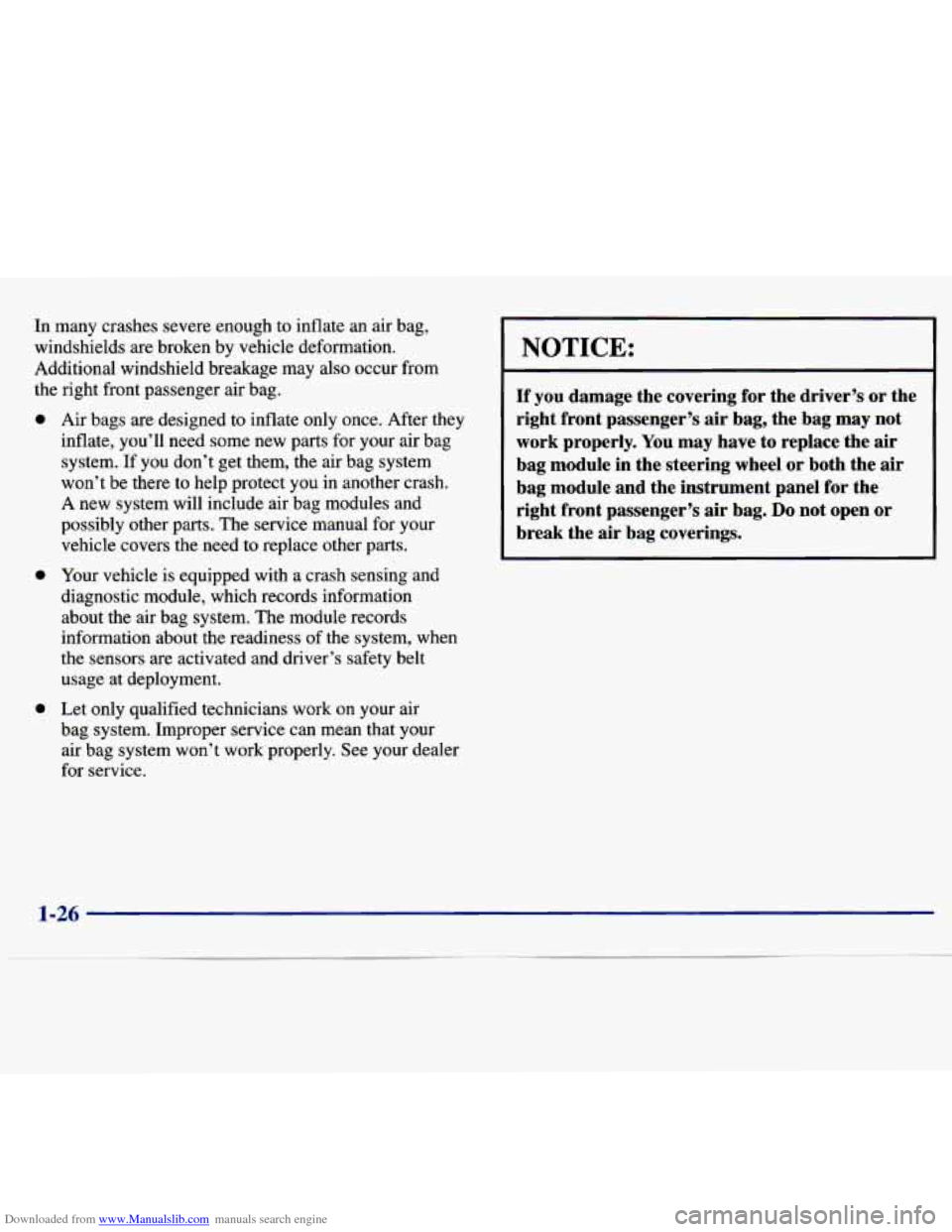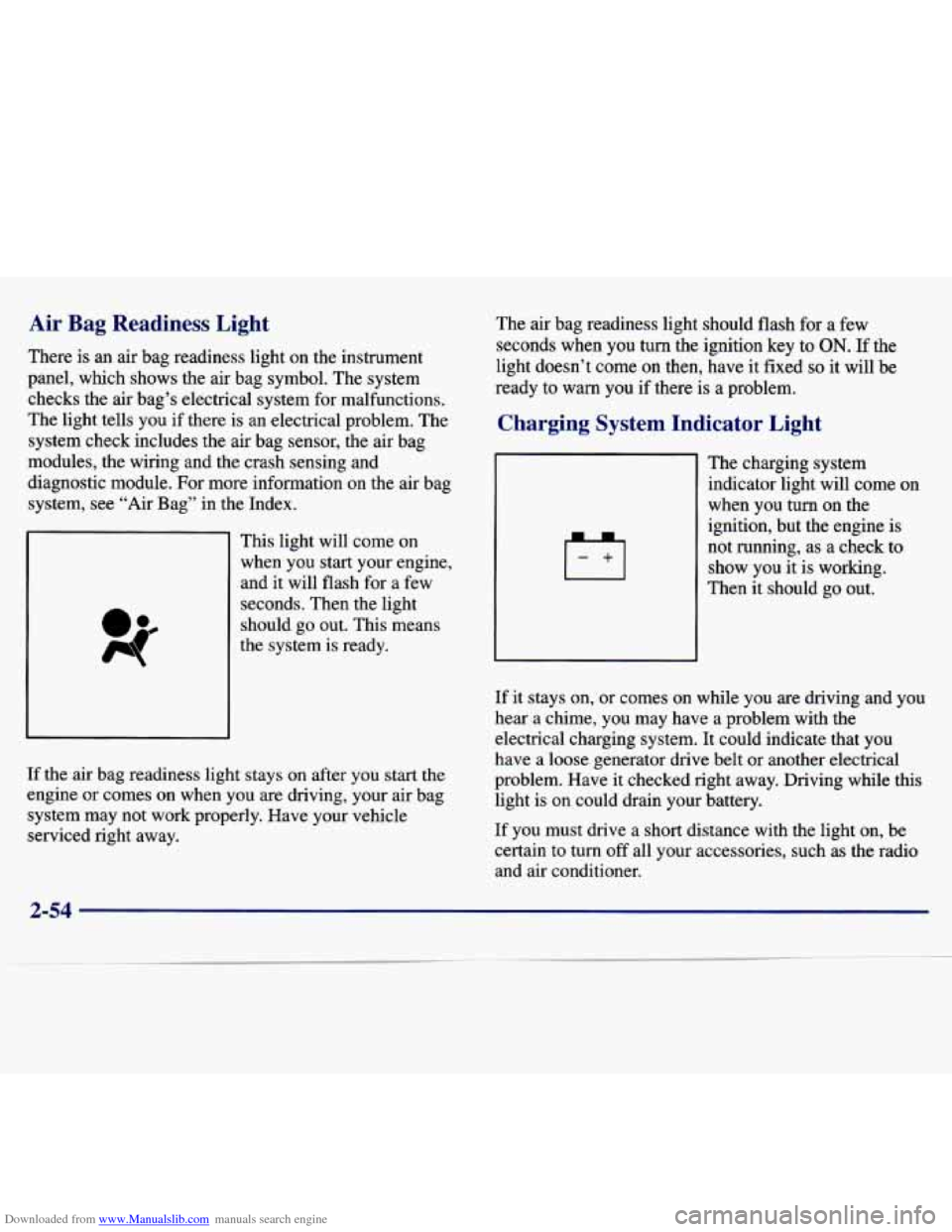Page 35 of 354

Downloaded from www.Manualslib.com manuals search engine In many crashes severe enough to inflate an air bag,
windshields
are broken by vehicle deformation.
Additional windshield breakage may also occur from
the right front passenger air bag.
e
a
Air bags are designed to inflate only once. After they
inflate, you’ll need some new parts for your air bag
system.
If you don’t get them, the air bag system
won’t be there to help protect you in another crash.
A new system will include air bag modules and
possibly other
parts. The service manual for your
vehicle covers the need to replace other parts.
Your vehicle is equipped with a crash sensing and
diagnostic module, which records information
about the air bag system. The module records
information about the readiness
of the system, when
the sensors are activated and driver’s safety belt
usage at deployment.
Let only qualified technicians work on your air
bag system. Improper service can mean that your air bag system won’t work properly. See your dealer
for service.
NOTICE:
~~
If you damage the covering for the driver’s or the
right front passenger’s
air bag, the bag may not
work properly.
You may have to replace the air
bag module in the steering wheel or both the air
bag module and the instrument panel for the
right front passenger’s
air bag. Do not open or
break the
air bag coverings.
1-26
Page 77 of 354

Downloaded from www.Manualslib.com manuals search engine NEUTRAL (N): In this position, your engine doesn’t
connect with the wheels. To restart when you’re already moving, use
NEUTRAL (N) only. Also, use
NEUTRAL (N) when your vehicle is being towed.
Shifting out of PARK (P) or NEUTRAL (N) while
your engine is “racing” (running at high speed) is
dangerous. Unless your foot is firmly on the
brake pedal, your vehicle could move very
rapidly. You could lose control and hit people or
objects. Don’t shift out of
PARK (P) or
NEUTRAL
(N) while your engine is racing.
~ NOTICE: I I I
Damage to your transaxle caused by shifting out
of
PARK (P) or NEUTRAL (N) with the engine
1 racing isn’t covered by your warranty. DRIVE
(D): This position
is for normal driving. If you
need more power for passing, and you’re:
Going less than 35 mph (56 M), push your
Going about 35 mph (56 M) or more, push the
accelerator all the way down. You’ll shift down to
the next gear and have more power. accelerator pedal about halfway down.
I
NOTICE:
If your
vehicle is seems to start up rather slowly,
or
if it seems not to shift gears as you go faster,
something may be wrong with a transaxle system
sensor.
If you drive very far that way, your
vehicle can be damaged.
So, if this happens, have
your vehicle serviced right away. Until then, you
can use SECOND
(2) when you are driving less
than
35 mph (56 km/h) and DRIVE (D) for
higher speeds.
Page 94 of 354

Downloaded from www.Manualslib.com manuals search engine Daytime Running Lamps / Automatic
Light Control
Daytime Running Lamps (DRL) can make it easier for
others to see the front of your vehicle during the day.
DRL can be helpful in many different driving
conditions, but they can be especially helpful in the
short periods after dawn and before sunset.
A light sensor below the defroster grille makes the DRL
and Automatic Light Control (ALC) work, so be sure it
isn’t covered. The
DRL system will make your
low-beam headlamps come on at a reduced
brightness when:
0 The ignition is on,
0 The headlamp switch is off,
The transaxle is not in PARK (P) and
The park brake is not set. When the DRL are
on, only your low-beam headlamps
will be on. The taillamps, sidemarker and other lamps
won’t be on. Your instrument panel won’t be lit
up either.
When it’s dark enough outside, the ALC system will
turn your headlamps on to full brightness. The other
lamps that come on with your headlamps will
also
come on.
When it’s bright enough outside, the ALC system will
turn off your regular lamps, and your low-beam
headlamps change to the reduced brightness of DRL.
To idle your vehicle with the DRL off, set the park brake
while the ignition is off. Then start the vehicle. The
DRL will stay off until you release the park brake.
As with any vehicle, you should turn on the regular
headlamp system when you need it.
2-37
Page 111 of 354

Downloaded from www.Manualslib.com manuals search engine Air Bag Readiness Light
There is an air bag readiness light on the instrument
panel, which shows the air bag symbol. The system
checks the air bag’s electrical system for malfunctions.
The light tells you if there is an electrical problem. The
system check includes the air bag sensor, the air bag
modules, the wiring and the crash sensing and
diagnostic module. For more information on the air bag
system, see “Air Bag” in the Index.
This light will. come
on
~ when you start your engine,
and it will flash for a few
seconds. Then the light
should go out. This means
the system is ready.
If the air bag readiness light stays on after you start the
engine or comes on when you are driving, your air bag
system may not work properly. Have your vehicle
serviced right away. The
air bag readiness light should flash for a few
seconds when you turn the ignition key to
ON. If the
light doesn’t come on then, have it fixed
so it will be
ready to warn you if there is a problem.
Charging System Indicator Light
The charging system
indicator light will come on
when you turn on the ignition, but the engine
is
not running, as a check to show you
it is working.
Then it should go out.
If it stays on,
or comes on while yoa aye- driving and you
hear
a chime, you may have a problem with the
electrical charging system. It could indicate that you
have a loose generator drive belt or another electrical
problem. Have it checked right away. Driving while this
light is on could drain your battery.
If you must drive a short distance with the light on, be
certain to
turn off all your accessories, such as the radio
and air conditioner.
2-54
Page 281 of 354
Downloaded from www.Manualslib.com manuals search engine Mini-Fuses 39) Powertrain Control
Module, Ignition
Anti-Lock Brakes
Ignition System
Back-up Lamps, Brake-Transaxle
Shift Interlock
Horn
Powertrain Control Module
Parking Lamps
Rear Defog, Daytime Running
Lamps, Climate Control System Mini-Fuses
47) Canister Purge Valve, Powertrain
Control Module, Exhaust Gas
Recirculation, Heated
02 Sensor
Fuel Pump, Injectors
Generator
Right-Hand Headlamp
Left-Hand Headlamp
Cooling Fan
WAC Blower (Climate Control
)
Fuse Puller for Mini-Fuses
Tach Test Point for
Diagnostic Testing
6-60